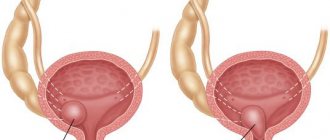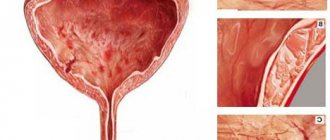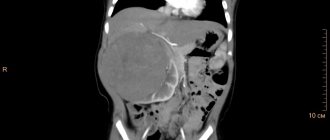Urinary tract infections (UTIs) are the most common diseases of the urinary system. This pathology occurs as a result of the penetration of pathogenic pathogens into the patient’s body, causing inflammatory processes.
Normally, when conducting a bacteriological examination of urine, up to 103 colony-forming microorganisms are determined in 1 ml. If the patient has a urinary tract infection, the number of pathogenic bacteria in the sample increases to one hundred thousand or more units per 1 ml. Due to the anatomical features of the structure of the excretory system, women are more prone to the development of inflammatory processes than men.
Depending on the localization of the inflammatory process in the urinary tract, the following forms of diseases are distinguished:
1. Infectious processes in the upper urinary tract. This group includes pyelonephritis, which is based on damage to the renal collecting system.
2. Lower urinary tract infection. The most common processes of this type are cystitis (inflammation of the bladder) and urethritis (damage to the urethra). In men, this group also includes prostatitis - inflammation of the prostate gland.
Another classification involves dividing UTIs into uncomplicated and complicated. Uncomplicated pathological processes are characterized by the absence of obstacles to the outflow of urine. In complicated infections, there are obstructions in the urinary tract that impede the outflow of urine and worsen the course of the underlying disease. Most often, infections of the urinary system occur acutely; when they manifest, the patient complains of deterioration of the condition. Such diseases are considered clinically pronounced. More rarely, inflammatory processes occur without any external manifestations that do not cause discomfort. This condition is called asymptomatic bacteriuria.
The structure of the urinary system
- The kidneys are a paired organ designed to perform 4 functions:
- blood filtration in order to remove toxins that are ingested with food, as well as those released during metabolism;
- maintaining water-salt balance: they remove excess water when there is excess and preserve water reserves when there is a shortage;
- management of mineral reserves: remove excess sodium, calcium, chlorine, but contribute to the accumulation of deficient minerals;
- regulation of blood pressure.
- The ureters are thin tubes through which fluid descends due to contractile movements of the walls.
- The bladder, which is a storage reservoir. After it is filled, it is emptied.
- The urethra, which passes through the penis in men, is located on the upper wall of the vagina in women.
Anatomical proximity to the genitals is the main cause of many ailments caused by the activity of parasites, viral, infectious, fungal microflora, sexually transmitted diseases.
Classification
Diseases of the excretory system organs are divided into several types based on a number of characteristics:
- According to the nature of the affected organ, they are distinguished:
- kidney diseases;
- diseases of the ureters;
- pathologies of the bladder;
The bladder is susceptible to various diseases - urethral diseases.
- Based on the nature of changes in the organs of the excretory system, they are distinguished:
- inflammatory diseases;
- stone formation;
- tumor diseases;
- immune diseases;
- anatomical deviations;
Horseshoe kidney is a congenital anatomical abnormality - hereditary diseases that change kidney function;
- metabolic diseases.
- According to the time of onset of symptoms, they are distinguished:
- congenital diseases;
- acquired ailments.
- Diseases of the excretory system can affect the daily process of excreting waste, waste and toxins in two ways:
- do not interfere with the excretory ability of the kidneys;
- develop renal failure;
- Diseases of the excretory system are distinguished by the type of course:
- acute, occurring with a vivid picture of the disease;
- chronic, turning into a series of exacerbations and remissions.
Causes
There are many reasons leading to urinary tract dysfunction. Most often, they are provoked by pathogenic microorganisms that are constantly present in the body and become active when favorable conditions occur due to weakened immunity. These include strains:
- staphylococci;
- coli;
- Pseudomonas aeruginosa;
- Klebsiella;
- chlamydia;
- streptococci;
- pneumococci;
- Candida fungi.
In addition, there are many provoking factors:
- hereditary predisposition;
- anatomical abnormalities in development;
- early infectious diseases such as tonsillitis or scarlet fever;
- hypothermia;
- failure to comply with hygiene rules;
- early onset of sexual life;
- promiscuous communications;
- mechanical or burn injuries;
- lack of vitamins, calories;
- metabolic disorder;
- diabetes;
- alcohol abuse;
- smoking;
- working with chemicals;
- congestion due to pregnancy, chronic constipation, neoplasms.
Urinary tract infections
Very often, infections cause problems with the urinary system in men. There are many pathogens that can lead to infection, namely:
- Klebsiella. Pseudomonas aeruginosa type. Typically seen in young boys.
- Microplasmas and chlamydia. These are organisms that infect the urethra, as well as the reproductive ducts. They enter the male body through sexual intercourse.
- Escherichia coli. It can enter the urinary system as a result of simple non-compliance with personal hygiene rules. Therefore, in this case, the prevention of diseases of the urinary system consists of basic compliance with the rules of personal hygiene.
Symptoms
Common signs for all pathologies of the urinary tract include:
- change in the daily amount of urine;
- feeling of emptiness after urination;
- false desire for evacuation;
- swelling of the limbs, areas under the eyes;
- the presence of blood in the urine, as well as sand and stones;
- change in the physical and chemical properties of urine: darkening, turbidity, increased concentration;
- burning sensation during urination;
- pain in the lower back, kidneys or pubis;
- incontinence.
Kidney inflammation
If swelling is detected during examination, we can conclude that amyloidosis or nephrotic syndrome is present. In this case, the face is characterized by a pale and puffy appearance, the eyelids are swollen, and the eyes are narrowed. In more severe cases, swelling spreads to the arms and torso
Both chronic nephritis and amyloidosis are characterized by pale skin. In addition to visual examination and patient complaints, palpation can provide information about symptoms. Normally, the kidneys cannot be palpated during palpation. Diseases such as a kidney tumor or kidney cyst lead to an increase in the size of the organ, which makes it possible to palpate the kidney. If the kidney is palpable on both sides, this may be a consequence of polycystic disease.
It should be noted that the kidneys can be percussed only if they are greatly enlarged. The tapping method can provide information about the kidney if it is relatively normal in size. If it is used in the lumbar area, and tapping causes pain, then pyelonephritis, paranephritis or kidney stones can be suspected.
Kinds
Due to their origin, pathologies are classified as congenital or acquired. The first group includes illnesses associated with developmental defects:
- Underdevelopment of the kidneys, manifested in metabolic failure, high blood pressure and swelling. Such symptoms can provoke diabetes, gout, hypertension, and lead to vision loss and dementia.
- Impairment of the structure of the bladder or ureters, which makes normal outflow of fluid impossible.
- With timely surgical intervention, congenital anatomical defects are easily restored without leaving a trace.
Content:
- The main causes of diseases of the urinary system
- Symptoms of kidney and bladder diseases
- How to prevent diseases - 10+ rules
- Features of the structure of the male and female urinary systems
- 5+ common ailments
Acquired pathologies
As for acquired diseases, the main causes here are injuries and infection.
Urethritis
Inflammation of the urethral mucosa due to infection or damage during diagnostic or therapeutic procedures.
Urethritis happens:
- primary, in which infection occurs through a canal;
- secondary, originating from other sources;
- nonspecific, caused by E. coli, fungal or staphylococcal flora;
- specific, caused by sexually transmitted infections: Trichomonas, chlamydia, gonococci.
The main signs of acute urethritis include:
- discomfort every time you go to the toilet (burning, stinging);
- problems with fluid outflow;
- pain in the pubic area;
- admixture of blood and pus in the urine.
What is urethritis: symptoms and treatment of urethritis in women and men. How and with what to treat urethritis
Cystitis
Inflammation of the bladder mucosa is infectious in nature and can be acute or chronic. In the first case, the patient feels very severe pain and pain when urinating. In the second, acute phases with rapid onset of symptoms are replaced by periods of remission with a complete absence of signs of the disease. The exacerbation phase is accompanied by:
- high temperature;
- pain in the lower abdomen;
- frequent urge to go to the toilet;
- chills;
- feeling of incomplete emptying;
- cloudiness of the urine, the appearance of blood or pus in it.
Factors that provoke cystitis include:
- hypothermia;
- hormonal imbalance;
- lack of hygiene;
- pathologies of a venereal or gynecological nature;
- the presence of neoplasms, stones;
- stagnation of urine.
Pyelonephritis
Stagnation in the urinary tract leads to the development of pyelonephritis, which is an infectious and inflammatory process. It can be unilateral or bilateral, depending on whether one kidney or both are affected. Pathogen microorganisms can immediately penetrate the organ (this infection is called primary) or from other affected tissues through the bloodstream (secondary). Pregnant women and men after 40 years of age are more susceptible to pyelonephritis. In the first case, compression is created due to the growing fetus, in the second - as a result of the prostate gland enlarging with age. In both cases, a person:
- temperature rises;
- lower back pain appears;
- urine becomes cloudy.
Prostatitis
Inflammation of the prostate gland begins under the influence of pathogenic microflora and occurs in men after the age of 50. Increasing in size, the prostate compresses the urinary canal, which inevitably leads to disruption of the outflow of urine. The most unpleasant consequences are sexual dysfunction and decreased sperm viability, which reduces the possibility of conception. Prostatitis can be acute (accompanied by fever and cloudy urine) and chronic, manifested in:
- soreness of the penis;
- frequent urination, accompanied by a burning sensation;
- erectile dysfunction;
- nervous tension (anxiety, irritability).
Amyloidosis
Amyloid is a protein substance. Due to disruptions in metabolism, it accumulates in the kidneys, which first causes their dysfunction, then atrophy and acute renal failure. Amyloidosis is provoked by:
- disruptions in the gastrointestinal tract;
- malignant neoplasms;
- chronic forms of tuberculosis, syphilis;
- lesions of the musculoskeletal system.
The initial stages are asymptomatic; as the patient’s condition worsens, the amount of protein in the urine increases, and symptoms such as:
- severe swelling of the face and limbs;
- accumulation of fluid in the abdominal and pleural areas;
- arterial hypertension;
- dehydration;
- dysfunction of the gastrointestinal tract, spleen, heart muscle.
Amyloidosis
Urolithiasis disease
The formation of hard concrements (stones) is a long process and can last for many years. They do not create any unpleasant sensations for a person as long as they do not move. The stones are formed in the form of crystals, often with uneven sharp edges, so when movement begins and they penetrate narrow places, for example, the ureters, a person experiences an attack of acute pain. Blockage of the passage leads to a decrease (cessation) of urine outflow. Patient:
- experiences girdle pain that intensifies with any movement;
- the temperature rises;
- Nausea and vomiting are possible.
The formation of sand and stones occurs as a result of poor nutrition: abuse of salty and smoked foods, alcoholic and mineral drinks.
Hydronephrosis
This is a pathological condition in which the outflow of fluid stops and the destruction of the kidney begins. Causes:
- injuries;
- inflammation;
- malignant neoplasms;
- drug abuse.
In the early stages, hydronephrosis is accompanied by:
- pain on the affected side, radiating to the genitals or thigh;
- instability of blood pressure;
- high fatigue.
In its advanced form, hydronephrosis occurs at high temperatures with bloody or purulent discharge.
Kidney cysts and tumors
Neoplasms are divided into benign (cysts) and malignant. The nature of the appearance of the former has not been fully studied. It is only known that pregnant women and overweight people are at risk. Cysts must be removed (medically or surgically) because as they grow, they will infringe on healthy tissue. Cancerous tumors are treated depending on their genesis. Symptoms indicating the presence of formations are:
- cramping attacks of pain;
- difficulty draining fluid;
- swelling;
- decreased performance.
Glomerulonephritis
Inflammation of the renal glomeruli, which perform a filtration function. Glomerulonephritis always affects both kidneys, as a result of which they cannot cope with their main cleansing task. In addition, urinary flow is impaired. The disease develops under the influence of viruses, bacteria or a distorted immune response, in which one’s own cells are perceived as hostile. Glomerulonephritis is accompanied by:
- lumbar pain;
- severe swelling;
- overheating of the body;
- arterial hypertension.
- Consequences:
- intoxication;
- hypertension;
- renal failure.
Nephropathy
Another type of damage to the renal glomeruli, which can be practically asymptomatic for years and become apparent already at the chronic stage. Nephropathy is distinguished:
- dismetabolic, disrupting filtration capacity;
- diabetic, which results in deformation of the glomeruli.
- The provoking factors are:
- uncontrolled consumption of medications;
- heavy metal poisoning;
- diabetes;
- congenital kidney anomalies;
- radiation damage.
Urinary incontinence
Occurs due to weakening of the muscles of the pelvic floor, as a result of various pathologies:
- obesity;
- chronic stress;
- hormonal imbalances;
- trauma to the genitourinary tract.
- Corrected by:
- special exercises that strengthen muscles;
- medicinally;
- operable.
Urinary incontinence. How to treat? Live healthy! 09/10/2018
Nephroptosis
Displacement of the kidneys relative to the anatomical norm due to:
- injury;
- decreased muscle tone of the peritoneum;
- sudden weight loss;
- heavy physical activity, including sports;
- muscle strains during pregnancy.
- Significant kidney prolapse can lead to:
- formation of stones;
- termination of pregnancy;
- heart attacks due to hypertension and strokes.
Which doctor treats diseases of the genitourinary system?
The genitourinary system combines several urinary organs, as well as the female and male reproductive organs. The number of diseases in this area, their causes and symptoms is so large and diverse that it cannot be managed by one specialist.
Pathologies of female genital organs are treated by a gynecologist, and pathologies of male genital organs by a urologist. The latter also treats urinary tract dysfunctions, but kidney pathologies should be addressed to a nephrologist. If diseases of the urinary system are viral or infectious in nature, then such a patient will be dealt with jointly by a urologist and a venereologist.
Without special knowledge, it is difficult for a person to determine which specialist to contact at the first symptoms, so the most correct decision would be to visit a therapist.
Diseases of the urinary system in children
Ailments associated with dysfunction of the urinary tract in children can be either congenital (developmental abnormalities) or acquired. Among the latter, the most common are:
- urethritis;
- cystitis;
- pyelonephritis.
- Signs:
- frequent urination;
- a small discharge of fluid every time you go to the toilet;
- incontinence;
- diarrhea;
- soreness in the lower abdomen.
Any of the above signs requires immediate contact with a urologist.
Diagnostics
Includes a set of standard techniques:
- Laboratory blood test, including:
- general analysis to determine the presence of inflammation;
- biochemistry, reflecting the functioning of internal organs;
- urine analysis to detect systemic diseases.
- Instrumental studies, including:
- ultrasound, detecting the presence of compactions, neoplasms of the internal structure;
- radiography, which determines the location of the organ and the presence of stones in it;
- CT scan, clarifying ultrasound readings;
- biopsy (if necessary) - examination of tissue for the presence of cancer cells;
- cystoscopy – visual examination of the bladder.
Research methods used in urology
When diagnosing urological diseases, it is impossible to establish an accurate diagnosis without the use of instrumental research methods.
- Using endoscopy, pathology of the kidneys, ureters, and urethra is determined. This is a highly informative and minimally invasive research method with minimal risk of complications.
- Cystoscopy is an alternative to endoscopy when it is difficult to determine the pathological process without an x-ray.
- Ultrasound of the pelvic organs is a mandatory procedure performed to identify the inflammatory process, developmental abnormalities and neoplasms.
- Multislice computed tomography is a method for early diagnosis of cancer, tissue differentiation, features of tumor growth, and blood loss.
- Magnetic resonance urography visualizes the accumulation of fluid in the cavity and the condition of the urinary tract.
- Needle biopsy – diagnosis of tumors, amyloidosis, determination of treatment tactics.
Laboratory diagnostics consists of:
- general blood test;
- blood tests for hormones;
- biochemical test (assessment of the acid-base state of the blood);
- creatinine clearance;
- general urinalysis;
- urine testing for sugar.
Treatment of the urinary system
Depends on the diagnosis and stage of the disease, severity, and associated pathologies. Therapy pursues goals such as eliminating infection, relieving pain, and alleviating general condition.
Treatment options include:
- establishment and strict adherence to food and water consumption;
- use of medicines;
- physiotherapy;
- physical therapy;
- using the experience of alternative medicine.
Drug therapy
- It is impossible to do without the use of medications. For treatment, the following groups of drugs must be used:
- Antibiotics:
- Amoxiclav;
- Azithromocin;
- Augmentin.
- Anti-inflammatory:
- Diclofenac;
- Ibuprofen.
- Diuretics:
- Furosemide;
- Indapamide.
- Antispasmodics:
- No-shpa;
- Spazmolgon.
- Pressure stabilizers:
- Captopril.
- Immunomodulators:
- Immunal;
- Viferon.
Surgical intervention
Surgery (strip or minimally invasive) is an extreme measure, necessary in cases of urinary incontinence or insurmountable obstacles to the release of stones, cysts, tumors.
The following surgical techniques are used:
- lithotrepsia – crushing of small stones;
- cystolithotomy – removal of large stones using an open method;
- transurethral resection – a minimally invasive method of removing tumors with a laser;
- endoscopic removal of small stones through the ureter;
- nephroptomy - excision of parenchyma affected by tumor or necrosis.
Folk recipes
Traditional medicine recipes cannot replace medication regimens, but act as additional help. Melissa infusion, which boosts immunity and helps remove stones, and cranberry-lingonberry decoction, which removes excess fluid and relieves inflammation, have proven themselves to be excellent.
To prepare lemon balm infusion, you need to take 2 tbsp. l. dry grass, pour 1 tbsp. boiling water and let it brew for a day, add a slice of lemon and drink on an empty stomach for two months. The course can be repeated.
The decoction is prepared as follows: take 300 g of lingonberries and 100 g of cranberries, put in a saucepan. Pour 2 liters of water and boil, cool and drink in small portions throughout the day. Carry out the procedure once a week for two to three months.
Prevention
A healthy lifestyle is the best protection against any illness. Prevention should include the following measures:
1. Exclude:
- hypothermia;
- uncontrolled consumption of alcohol, pickles, smoked foods, medications;
- smoking;
- promiscuous intimate relationships;
- swimming in rivers and lakes - potential sources of infection.
2. Improve your nutrition by including in your diet:
- fish and meat;
- dairy products;
- vegetables and fruits;
- berry cocktails;
- porridge;
- durum wheat pasta.
3. Strictly observe hygiene rules.
4. Lead an active lifestyle.
5. Do not self-medicate.









